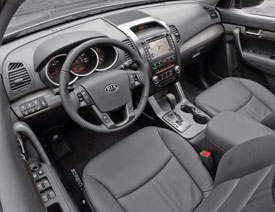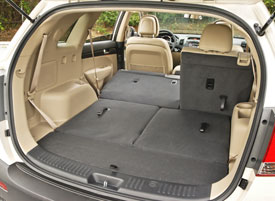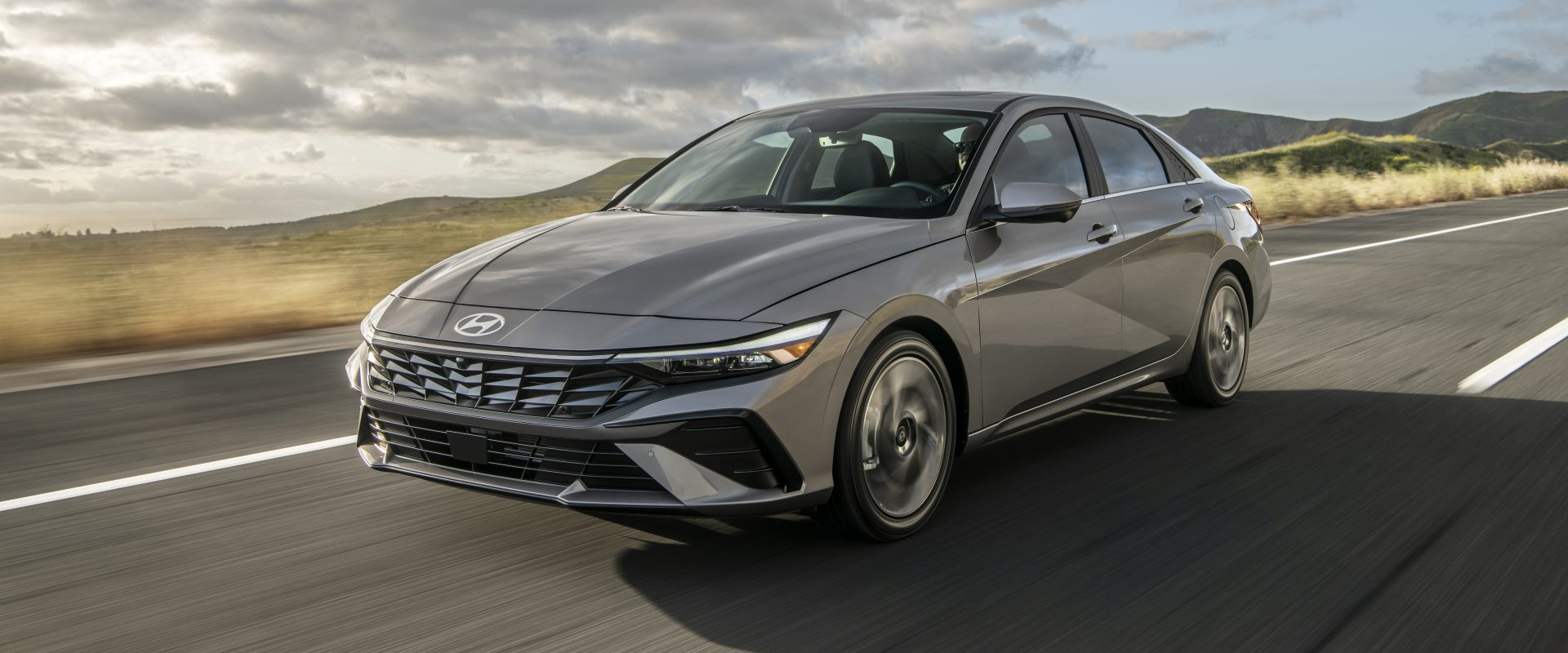2011 Kia Sorento
It’s a clear sign of the times. Kia, responding to current market tastes, has redesigned their compact Sorento without its original body-on-frame SUV chassis, opting instead for a crossover utility unibody. Now Kia hopes this move will greatly expand the Sorento’s appeal. But does being more like a car, and less like a truck, make for a better Sorento?
Besides its chassis transformation, the second generation 2011 Kia Sorento is also the Korean brand’s first vehicle to have its assembly transferred to American soil. That takes place at a huge new facility in West Point, Georgia.
Still, Sorento enters an already crowded compact CUV segment, and faces stiff competition from other quality entrants like the Toyota RAV4, Nissan Rogue, and also new Chevrolet Equinox. Like the Equinox, the Sorento is called a compact, but it’s nearly mid-size both outside and inside. Using a chassis shared with the Hyundai Santa Fe, Sorento’s length of 183.9 inches is over three inches longer than before, if slightly lower for better aerodynamics.
The totally refashioned exterior echoes Kia’s new, bolder, front-end theme begun with the Forte. The grill and flared-back headlights form a continuous arch that is most appealing.
 Based on the KND-4 concept from the 2007 Los Angeles Auto Show, the production Sorento has a similar sweeping profile and athletic stance. Roof rails are optional. The rounded rear-end also exudes lots of presence, with large LED taillights that extend into the liftgate. Wheels are 17 and 18-inch alloys, with a mirror finish optional on top EX trim.
Based on the KND-4 concept from the 2007 Los Angeles Auto Show, the production Sorento has a similar sweeping profile and athletic stance. Roof rails are optional. The rounded rear-end also exudes lots of presence, with large LED taillights that extend into the liftgate. Wheels are 17 and 18-inch alloys, with a mirror finish optional on top EX trim.
While the original Sorento offered a pair of V6s, the 2011 allows a more varied choice. Standard is a 2.4-liter inline-4 shared with the Forte SX. Output is 175 horsepower and 169 pound-feet of torque.
Optional is an all-new 3.5-liter V6 with a best-in-class 276 horsepower and 248 pound-feet of torque. But even with it, trailer towing takes a beating: 3,500 pounds, down from 5,000 last year.
A six speed manual is standard with the I-4. Kia’s first home-grown six-speed automatic is an option, and standard with the V-6. A single speed four-wheel drive system with locking center differential can be fitted to either engine. And, even with front drive, useful Hill Start Assist and Downhill Brake Assist are included.
Government Fuel Economy Ratings for our front-drive four-cylinder automatic are good at 21 city/29 highway on regular gas. We saw a respectable 24.3 miles per gallon in real world driving. But, you do pay for that efficiency on the track. Our I-4 Sorento huffed from 0 to 60 in a long 10.1 seconds. And the quarter mile dragged out to 17.7 seconds at 78 miles per hour. The Sorento felt breathless all the way down the track. Shifts were lazy and power-robbing.
 The Sorento’s new unibody employs a MacPherson strut front, and multilink rear suspensions. Electronic Stability Control is standard.
The Sorento’s new unibody employs a MacPherson strut front, and multilink rear suspensions. Electronic Stability Control is standard.
Unfortunately, none of this helped inspire a high level of confidence in our handling tests. Steering was quick enough but with little feedback, and body roll was excessive.
The one bright spot in Sorento’s track performance was braking. The all-disc, ABS brakes delivered arrow-straight, near fade-free stops of a short 120 feet on average from 60 to 0. The pedal was firm with positive feedback.
On normal roads, the Sorento is a lot more self-assured. It’s comfortable and quiet, feeling well anchored at even elevated interstate speeds.
That comfort continues inside, where Kia used the extra body length for more cabin space and versatility. With both five- and first time three-row seven-passenger models, it’s now a big family-mover. The modern, tech-inspired dash is defined by overlapping gauges and practical controls. Our EX model’s well-padded seats came with standard eight-way power for the driver, and optional heat.
Standards include a tilt/telescoping wheel with audio and Bluetooth controls. Satellite Radio and a USB port are on board too. A 550-watt Infinity upgrade, navigation, and even a dual sunroof, are available. Our EX added push button start, and a backup camera with rear view mirror display.
Those in the 60/40 second row will find it quite roomy, with a welcomed increase in legroom. Kids will like the 50/50 split folding third row, but not adults. Behind the third row is 9.1 cubic feet of space that expands to 37 cubic feet when folded, and an excellent 72.5 with all seats down. A reversible load floor and handy underfloor compartment add to this CUV’s overall practicality.
And that practicality also speaks to Kia’s value pricing. In fact, the base price for the 2011 Sorento is down from last year starting at $20,790. Sorento base prices top out at $29,690.
Combine that with Kia’s vastly improved quality reputation, and one of the best warranties going, and it’s no wonder they continue to chalk up sales gains. The new Sorento’s track performance may be lacking, but we have no qualms with its packaging. So, the 2011 Kia Sorento is indeed a better answer to what today’s family buyers want. And, yes, it’s a better Sorento, too.
Specifications
- Engine: 2.4-Liter Inline-4
- Horsepower: 175
- Torque: 169 Lb Feet
- 0-60 MPH: 10.1 Seconds
- 1/4 Mile: 17.7 Seconds @ 78 MPH
- 60-0 MPH: 120 Feet
- EPA: 21 MPG City/ 29 MPG Highway
- Mixed Loop: 24.3 MPG
2024 Hyundai Elantra
Basic Transportation At Its Best…And That Is A Compliment
For those of you who write in every week bemoaning the fact that all we seem to do around here is test incredibly expensive cars and EVs that only the very well to do can afford, this one’s for you. It’s a commuter and budget friendly mainstay from Hyundai, the compact Elantra sedan. And, it has been nicely updated for 2024.
We clearly do enjoy driving high-performance machines and ultra-luxury rides around here, but like most of you, when it comes time to drive home at the end of a long workday, we do so in something much more practical and affordable, like this 2024 Hyundai Elantra sedan.
If you’re thinking the front end has gotten more aggressive, you’re right. Hyundai calls it a “Shark Nose” theme, and we’re guessing they were thinking more Great White than Hammerhead, though Megamouth shark would also apply. It helps for a low and wide look; more substantial than the typical compact. Other additions for ’24 include slimmer daytime running lights, revised stainless steel Hyundai emblem, reshaped front fenders, sport sedan-style rear diffuser with silver trim; a parametric pattern added to the C-Pillar, and new LED taillights that take up a lot more space on the highly sculpted decklid. Plus, new wheel designs in sizes ranging from 15- to 18-inches.
Standard engine in SE, SEL, and Limited grades is this naturally aspirated 2.0-liter I4 with 147 horsepower and 132 lb-ft of torque. Even with no hybrid assistance, it gets substantial Government Fuel Economy Ratings of 31 City, 40 Highway, and 34 Combined; we averaged a great 38.6 mpg of Regular.
Those high fuel economy numbers mean acceleration times are pretty high as well. It was in no particular hurry to get off the line at our test track, as after a slight jolt of power, it felt pretty sluggish going down the track, taking us a lengthy 9.4 seconds to hit 60 mph. Hyundai’s Intelligent Variable Transmission has some realistic simulated gear shifts built in, and they not only provided the feel of a true automatic, but kept engine noise from becoming overbearing. And while this 2.0-liter may not be a house-on-fire off the line, it has no problem keeping up with traffic, and feels like just the perfect amount of power for a practical and safe commuter car.
There are other engine options too. Two choices if you want to go faster, a 1.6-liter turbo with 201 horsepower in the Elantra N Line, and a 276-horsepower turbocharged 2.0-liter for the Elantra N; plus, one with even better fuel economy, a 1.6-liter hybrid with a 139 horsepower total output.
And despite some significant understeer, there was good feel through the cones of our handling course, both in steering and chassis feedback. We wouldn’t quite call it “point and shoot,” but it responded to inputs fairly quickly, with only moderate body roll. All-in-all, when it comes to performance, it doesn’t claim to bring a whole lot to the table, but does clearly overachieve with what it does bring.
And Hyundai is always overachieving when it comes to packing in features, yet has found a way of keeping things refreshingly simple with a good mix of touchscreen and manual controls. Lots of space too, both up front in the surprisingly wide front buckets, and in the rear bench with ample room for three. Updates for all Elantra interiors include softer materials on the door panels, upgraded instrumentation and additional charging ports, plus a surround view monitor and new H-Tex simulated leather for Limited trim.
Elantra pricing starts with an SE at $22,775, the SEL comes in at $24,725, Limited begins at $28,215, and the sporty N Line starts at $29,615. If you’re interested in the hybrid, base Blue starts at $27,400 with Limited at $30,600.
Some might say there’s not a whole lot that’s earth shaking about the 2024 Hyundai Elantra, but that’s mostly why we like it so much. When it comes to just delivering good, basic transportation with a high dose of unexpected amenities, Hyundai delivers once again.
Specifications
- Engine: 2.0-liter I4
- Horsepower: 147
- 0-60 mph: 9.4 seconds
- 60-0 Braking: 111 ft (avg)
- MW Fuel Economy: 38.6 MPG (Regular)
- Transmission: IVT
- Torque: 132 lb-ft
- 1/4 Mile: N/A (Track Maintenance)
- EPA: 31 City / 40 Highway / 34 Combined







